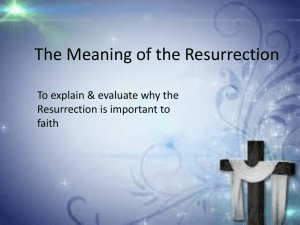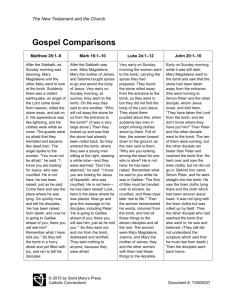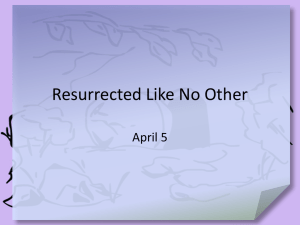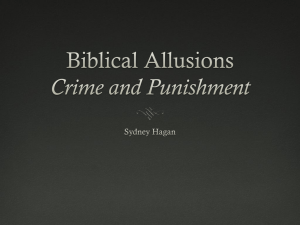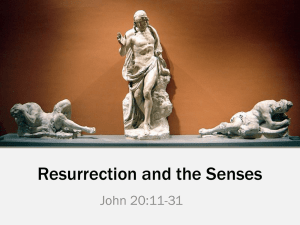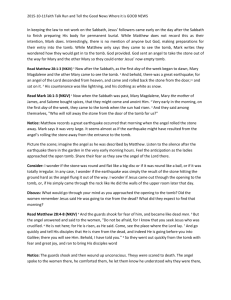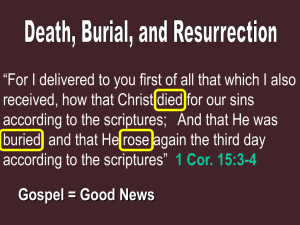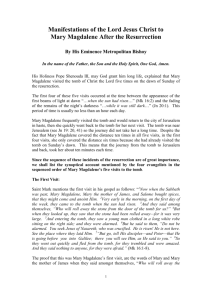No Angels Visitant
advertisement
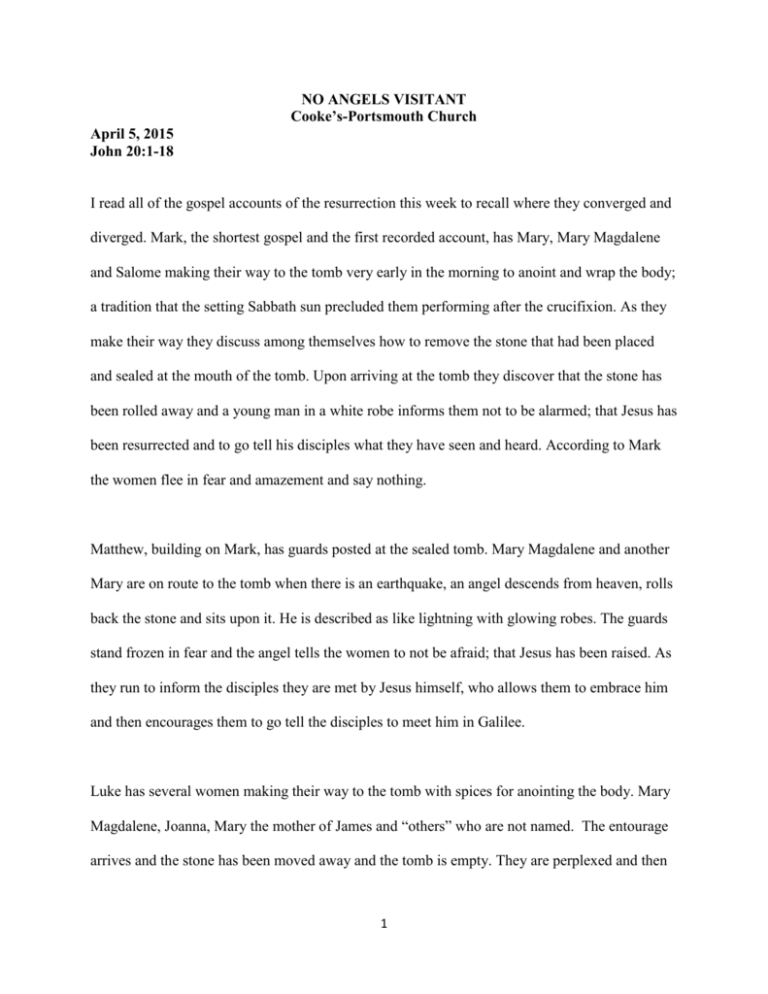
NO ANGELS VISITANT Cooke’s-Portsmouth Church April 5, 2015 John 20:1-18 I read all of the gospel accounts of the resurrection this week to recall where they converged and diverged. Mark, the shortest gospel and the first recorded account, has Mary, Mary Magdalene and Salome making their way to the tomb very early in the morning to anoint and wrap the body; a tradition that the setting Sabbath sun precluded them performing after the crucifixion. As they make their way they discuss among themselves how to remove the stone that had been placed and sealed at the mouth of the tomb. Upon arriving at the tomb they discover that the stone has been rolled away and a young man in a white robe informs them not to be alarmed; that Jesus has been resurrected and to go tell his disciples what they have seen and heard. According to Mark the women flee in fear and amazement and say nothing. Matthew, building on Mark, has guards posted at the sealed tomb. Mary Magdalene and another Mary are on route to the tomb when there is an earthquake, an angel descends from heaven, rolls back the stone and sits upon it. He is described as like lightning with glowing robes. The guards stand frozen in fear and the angel tells the women to not be afraid; that Jesus has been raised. As they run to inform the disciples they are met by Jesus himself, who allows them to embrace him and then encourages them to go tell the disciples to meet him in Galilee. Luke has several women making their way to the tomb with spices for anointing the body. Mary Magdalene, Joanna, Mary the mother of James and “others” who are not named. The entourage arrives and the stone has been moved away and the tomb is empty. They are perplexed and then 1 suddenly two men in dazzling clothes stand beside them asking, “Why they seek the living among the dead.” They run to inform the disciples, who do not believe what they say. Peter goes to the tomb and sees that the stone is indeed rolled away and the inside lacking a corpse, but simply goes home amazed. Each of the synoptics has varying differences, but they all have some angelic being giving them the news. John’s account is very different. Mary Magdalene arrives early and alone. There are no other women to corroborate her story; no spices to anoint and wrap the body. Just a lone heart- broken woman who sees the open tomb and assumes the worst. She runs to inform the disciples that the body has been stolen away and has been lost to them. Two disciples run to the tomb to see for themselves and then leave the poor, grief stricken woman alone. Of all of the gospel accounts of the resurrection, this may be the one that most mirrors our experience. We take on faith that the empty tomb means life and not death. The resurrection takes place before there any witnesses on the scene: no spice bearing women. And Mary Magdalene becomes a kind of everyman and everywoman who forms an impression. The reader knows that the empty tomb implies resurrection and that the gardener is Jesus, but until she hears him speak her name, grief and confusion weigh supreme. We too can be blinded by grief and sometimes need to be graced with divine intervention to have our eyes opened and our fears allayed. “Do not stand at my grave and weep, I am not there, I do not sleep.” These are words from a poem that I have used by times in the celebration of a life at a funeral. They are a part of a larger work that had been cut out of the paper by a woman on my first pastoral charge who was battling 2 cancer. Jean (Embury) kept them near the couch on a metal folding tray that served as a catchall for dishes, telephone and medication. She handed the verse to me on the first visit that I had with her after my arrival as a fledgling upstart and she said, “I want this poem read at my funeral.” For Jean the poem was an expression of faith, because she believed steadfastly that there was more to life and existence than what was defined by the span of a lifetime. But it was also a pastoral act. It would become her way of speaking from beyond the grave to the small community of Kenton who knew her as a friend, neighbor, teacher, church organist, and choir director, and would remind us all, when her physical life did come to an end, that one’s spirit remains as long as memory allows. The full text of the poem written by Mary. E. Frye in 1932, which is probably familiar to most, goes like this: Do not stand at my grave and weep I am not there, I do not sleep. I am a thousand winds that blow I am the diamond glints on snow. I am the sunlight on ripened grain I am the gentle autumn’s rain. When you awaken in the morning’s hush I am the swift, uplifting rush Of quiet birds in circled flight. I am the soft stars that shine at night. Do not stand at my grave and cry; I am not there, I did not die. 3 I rather like the sentiment of the poem that reminds, in a comforting way, that life is eternal. I like the gentle reminder that though we may miss the sound of a voice, or the way that a loved one interpreted a piece of music, or their company during a televised hockey game, that the physical separation is just that. The spirit; the essence of who a person was and is cannot be completely lost to us. If we are quiet and thoughtful and open, we will see and feel the reminders of their presence with us, despite their physical absence. And we too may discover that we are touched from beyond the grave by the power of the resurrection. This is the message of Easter. Good Friday has not been whitewashed forever because of the sacrificial death of God’s beloved son. Even those closest to him wept at his grave, presuming the indignity of his cruel death had been exacerbated with the disappearance and presumed violation of his mortal remains. The empty tomb did not immediately signal his resurrection and the empty tomb did not cause Mary Magdalene to dance in joy but rather to weep. She stood before his empty tomb and she cried the tears of disillusionment and disappointment. Her first impression was not that he lived, but that he had suffered further indignity by having his body stolen. It was more than she could take, and so she weeps. When Jesus approaches the grief wrought Mary in the Garden he asks her why she weeps. There is no judgment attached to her tears. He asks her why she cries and whom she seeks. Presuming him to be a gardener she asks the whereabouts of Jesus’ mortal remains, and then Jesus speaks her name. What her eyes have misinterpreted becomes clarified in hearing the one that she loved call her by her name. Her eyes deceived, her ears did not, and she is immediately awash in relief. 4 There is not a hint of hesitation in her response as she runs to embrace the one who has been miraculously returned to her. She is kept from holding him, however, because according to John he is in the process of ascending. I think that there is a significant dimension to Jesus withholding his embrace from her. She cannot cling to the Jesus who was but must somehow embrace the Christ who is. Things have changed and been changed forever following the gore of the crucifixion and the mystery of resurrection. As contemporary persons of faith we have a relationship with both the historical Jesus of the gospel and the risen Christ of the resurrection. We have not seen as Mary was privileged to both hear and see. But we have heard the stories of his life and deeds and have come to see the significance of his legacy through faith. And precisely because of our relationship with both the historical Jesus and the resurrected Christ, we have an understanding of resurrection and ongoing resurrection in the wake of loss and death. We understand what the poet was suggesting when she reminds that life goes on in the world around us and in the heaven of our dreams. For Mary Magdalene, and the disciples hearing and seeing were the requisites for faith. For we, who live long after the fact, the hope of the resurrection is taken on faith. For as much as naysayers are inclined to accuse the person of faith of naiveté we see the evidence of life transformed in the rush of the wind, in the diamond glint on snow, and in the eternal now of life as we know it and in the life yet to come. We have been blest with new eyes for seeing; new ears for hearing. When Jesus sighed his final words from the cross in John’s account of the crucifixion he said, “It is finished.” Life as it was known before has been changed forever. There 5 is physical death but there is life and new life made possible through the resurrection. Faith has transformed knowledge. We understand that things have been forever changed because of the resurrection. We may stand at gravesides and weep as urn and casket are lowered, but there is a part of us that takes note of the trees in the cemetery springing to life, and birds circling on high, and the faith seated resolve which attests that this is not all that there is. There may be no young men arrayed in dazzling white robes who visit us and tell us to have no fear, but flesh and blood angels disguised as gardeners may yet and still reach out to comfort us in our sadness and disappointment. Like the words of a poem shared at a funeral service many years ago. More than thirty years after her death, I still recall Jean’s life whenever I hear these words. “Do not stand at my grave and cry; I am not there I did not die.” This is the power of the resurrection that we take on faith, and, even those who attest to having no Christian faith, still believe in the eternal now of life. This too, I believe, is an act of divine grace, as God continues to proffer peace, hope and love. For Mary, tears were transformed to joy and despair to hope. In hearing she was able to see. May God open our ears to the still small voice of hope and encouragement so that we too might see proof of the hope of resurrection. Thanks be to God. Amen. 6

